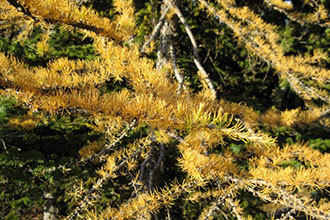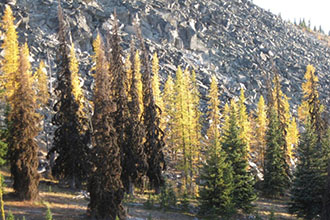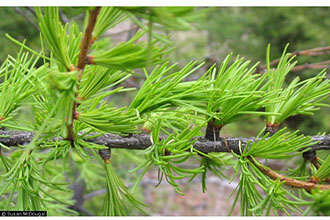USFS Plant Database
Western larch is a fast growing, long-lived, deciduous conifer native to alpine and subalpine forests of the northwestern United States and adjacent Canada. Trees over 900 years old have been reported...Western larch occurs in mountain valleys and lower slopes, often in somewhat swampy areas. It needs well-lighted areas for maximum development, so it performs best in open stands. Western larch is usually found at elevations of 460-1,700 m in the northern portions of its range and may be found at elevations over 2,100 m in the southern parts of its distribution.
Western larch is not considered a climax species, but it is a long-lived early successional species...Western larch uses nitrogen more efficiently than evergreen trees, reducing its dependence on soil for nitrogen and increasing its effectiveness as a pioneer in disturbed, infertile habitats. This aggressive pioneer quickly colonizes disturbed areas and grows rapidly, remaining taller than its associates for approximately 100 years...In the absence of disturbance, shade tolerant associates form understories that shade out future generations of western larch seedlings. However, western larch's long lifespan and resistance to damage from fire and pathogens accounts for the presence of relict trees in late-successional stands that can repopulate the stand if fire or other disturbance removes competition and opens the canopy.
The currently accepted scientific name for western larch is Larix occidentalis Nutt. (Pinaceae).
Except when it is young, western larch is rarely found in pure stands. Its most common tree associate is Douglas-fir (Pseudotsuga menziesii), and on low-elevation dry sites it is found with ponderosa pine (Pinus ponderosa). Common associates in warm, moist forests include grand fir (Abies grandis), western hemlock (Tsuga heterophylla), western redcedar (Thuja plicata), and western white pine (P. monticola). In cool, moist, subalpine forest types Engelmann spruce (Picea engelmannii), subalpine fir (A. lasiocarpa), lodgepole pine (Pinus contorta), and mountain hemlock (Tsuga mertensiana) are more common.
Hardwoods that occur with western larch include paper birch (Betula papyrifera), black cottonwood (Populus balsamifera ssp. trichocarpa), and quaking aspen (P. tremuloides).
Major understory associates include common beargrass (Xerophyllum tenax), huckleberry (Vaccinium spp.), thimbleberry (Rubus parviflorus), menziesia (Menziesia ferruginea), ninebark (Physocarpus malvaceus), serviceberry (Amelanchier spp.), Oregon boxwood (Paxistima myrsinites), and bearberry (Arctostaphylos uva-ursi).
Western larch is not considered a climax species, but it is a long-lived early successional species. (Plant Database)



